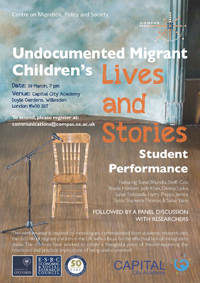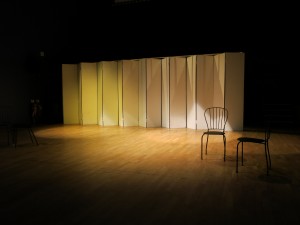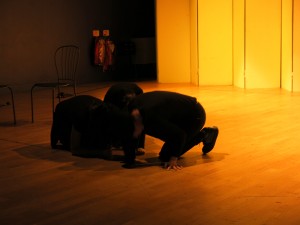“I have just seen more learning this evening than I do in a whole curriculum”. That was the response of an academic in the audience at the performance of “Undocumented Migrants Children’s Lives and Stories” by students at Capital City Academy, in Brent London on 19 March 2015.
This was the second performance produced by the project “Exploring Migration: Research and Drama in Schools”. This project explores the issues facing undocumented migrant families in the UK and works with school children using theatrical material developed from the COMPAS project “Undocumented Migrant Children in the UK”. The first performance was put on by students from Lord Williams’s School, Thame, in Oxford in December 2014. The lessons learned from that initial performance, about impact, public engagement, and the use of theatre as a tool for disseminating research were very much echoed in London (see previous blog here). But in London, where we worked with 10 enthusiastic students from Year 9, 10 and sixth form, what was emphasised throughout the rehearsal process, the performance and the Q&A was education and the learning experience.
Education
The merits of teaching young people about a complicated issue such as migration through drama was valued by many audience members. These included teachers, parents, members of the local community, and migration organization representatives. The performance led to a lively and considered discussion, focusing to a large extent on the students’ learning experience and their own reactions to their performance. As a key aim of the project it was very rewarding to not only hear this brought up as a discussion point, but also the students’ answers. They eloquently commented on their enjoyment of taking part in the project and the understanding they gained not only of others’ experience but also of their own their families’. Throughout the discussions the theme of education kept recurring, on the one hand in relation to themselves and their learning and on the other with regards to the significance of education more generally. In being asked what their own attitude to education was, based on the stories they had just performed (related to the precarious position of some undocumented migrant children in their schools, due to fear of deportation) one student poignantly answered “The right to education should be of utmost importance”.
Changing perceptions
This attitude to education was also reflected in its role in changing perceptions. A student from Lord Williams’s said to me recently “it was really fun, more fun than I thought it would be. My opinions have definitely changed”. I did not press her about what they had changed from or to, as the important message was that a thought process had occurred and that this had been fun! The purpose of educating on complex issues such as migration is about starting a meaningful dialogue and independent thought. Thought which can be based on personal, direct understanding and basic empathy, which is why theatre is such a useful tool. To establish this understanding it is necessary to provide information in an easily digestible but also powerful format, often unachievable through the more traditional “academic presentation”. As Gunaratnam has argued ‘artistic representation can convey meanings that are independent of linguistic systems and rationalist, sequential ordering – this is why I believe that art can move us at an emotional and sensual level and have an impact upon thinking’ (2008: 283). I recently read out a monologue from the material used in this project at the DTC London Conference, which prompted the comment that “there was more information in there than in several PowerPoint slides and numbers”.
Throughout the course of the project, the students are provided with the background information to the stories, the stories themselves, and discussion is related to current news stories, their own existing knowledge, attitudes and experiences. It is clear, however, from the students’ answers that they had been thinking about the issues far beyond the rehearsal room and gained insight not only to the stories on the script pages, but also into their own lives. One student stated that she had become even more aware that “you are a person first and a migrant second, not the other way around”. Another stated that understanding the personal stories had “humbled” her when thinking about the experiences of her own parents and grandparents who had migrated to the UK for a better life which she can now enjoy. This journey of understanding began in the first session when an exercise highlighted their own immigration issues to some of the students. This genuineness and openness on behalf of the students about their own experiences not only led to a unique interpretation and performance of the monologues, but also created new learning for us as researchers. As such the research process stays alive beyond the confines of the written, published word and engages in a representation of lives and lives contexts with a live sociology (Back 2012).
 The students then shifted the focus of this performance from the narrower emphasis on immigration status to the migration experience more generally. They opened the performance with voices recorded by other people in the school about where they and their families were from and where they felt at home, illustrating the vast diversity existent in a London school. It ended with the performers in a line all stating one by one “I am a migrant” culminating in the line “These are our stories. What’s yours?” This format clearly shows the students’ initiative, consideration of the overall narrative of the piece and of migration stories, appreciated the common human experience, and had a wish to communicate this. I stood nervously waiting for a reply when an audience member asked the students “what did you want the audience to take away from this performance? What is it that you are trying to say?”. But the students did not disappoint as one confidently spoke out and stated that they wanted to highlight that there are many different ways of being a migrant in the UK, because so many have some migration background, and make the audience think about their own connection to migration.
The students then shifted the focus of this performance from the narrower emphasis on immigration status to the migration experience more generally. They opened the performance with voices recorded by other people in the school about where they and their families were from and where they felt at home, illustrating the vast diversity existent in a London school. It ended with the performers in a line all stating one by one “I am a migrant” culminating in the line “These are our stories. What’s yours?” This format clearly shows the students’ initiative, consideration of the overall narrative of the piece and of migration stories, appreciated the common human experience, and had a wish to communicate this. I stood nervously waiting for a reply when an audience member asked the students “what did you want the audience to take away from this performance? What is it that you are trying to say?”. But the students did not disappoint as one confidently spoke out and stated that they wanted to highlight that there are many different ways of being a migrant in the UK, because so many have some migration background, and make the audience think about their own connection to migration.
Next steps
In the “third phase” we will be taking the project to a primary school in Birmingham. This will again be a different experience, requiring a different approach for younger students.
One of the most interesting elements about the educational aspect of this project is its diversity, in terms of the students’ ages and diversity. This makes work with each group unique and a different experience. Vanessa Hughes and I will be continuing this work through a new company, ActREAL (Research, Experience and Learning), creating learning through drama and bringing new, cutting-edge UK research to schools.
--------------------
Gunaratnam, Y. (2008) ‘Where it the Love? Art, Aesthetics and Research’, Journal of Social Work Practice, 21 (3), pp. 271-287
Back, L. (2012) ‘Live sociology: social research and its futures’, The Sociological Review, 60 (S1), pp. 18-39.

